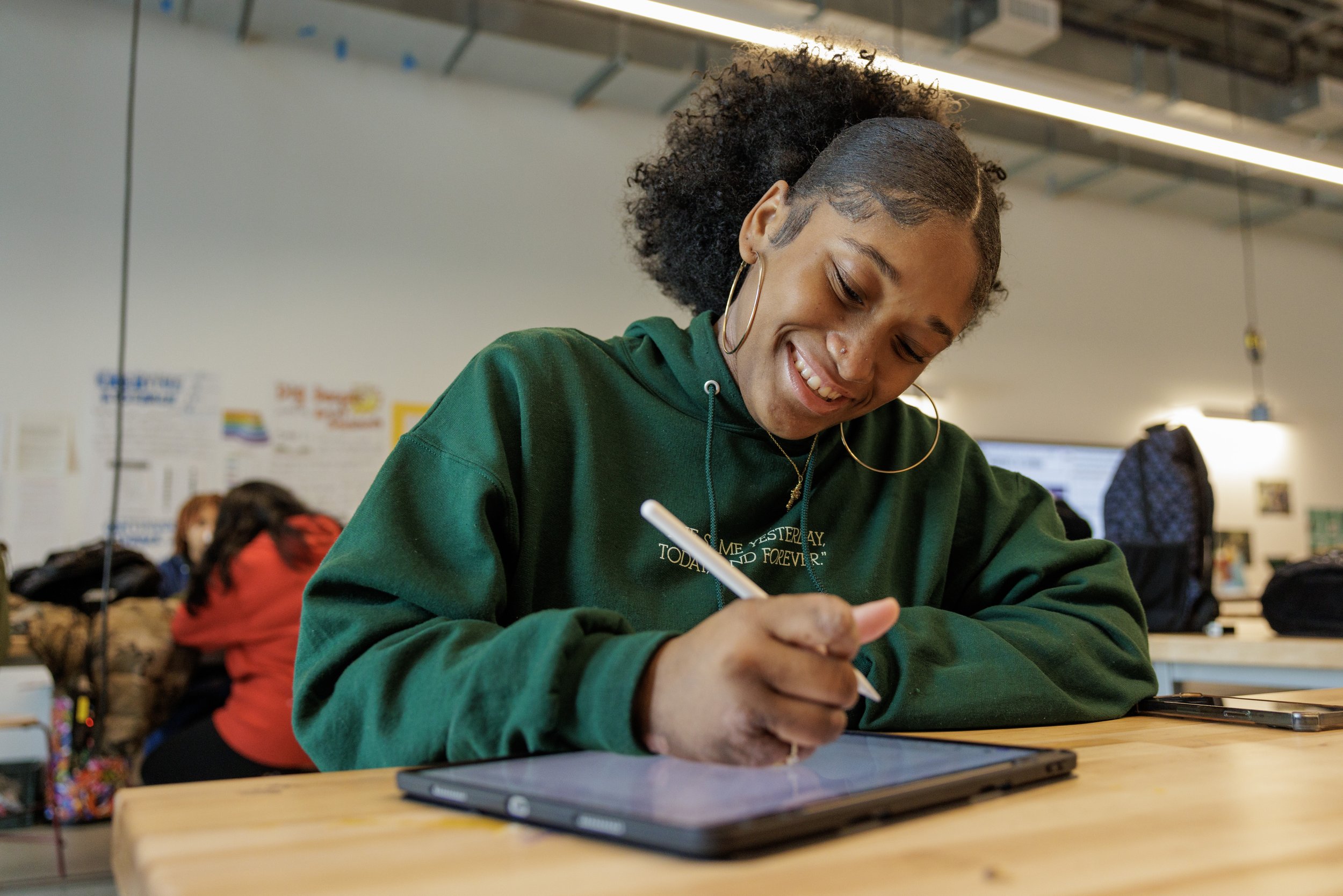Mural Arts
Mural Arts from Concept to Creation
6th Through 8th Grade • English Language Arts (ELA) & Visual Arts - Mural Painting / Public Art
Lesson Overview: This lesson plan focuses on creating a mural, integrating visual arts with academic standards and arts-integrated teaching practices. The plan emphasizes collaboration, community storytelling, and developing artistic skills. The lesson plan guides students through creating a collaborative 6' x 8' mural that powerfully explores heritage, identity, and community resilience through a structured five-session journey—from initial mapping and thematic research to color palette selection, design development, and painting techniques—ensuring students gain both technical proficiency and conceptual depth. Beyond developing artistic skills, this lesson empowers students to understand how public art functions as a transformative medium for community storytelling, collective healing, and meaningful communal change, while fostering collaborative problem-solving throughout the creative process.
Learning Objectives | Students Will:
Make connections in significant historical events through the modern medium of podcast.
Prepare and present selected theme-based discussion and commentary vital to processing current events in light of troubled histories in student’s communities.
Understand the significance of murals as a form of public art and community storytelling.
Explore and articulate themes related to family heritage, identity, and community resilience.
Develop skills in mural mapping, thematic design, and collaborative planning.
Gain hands-on experience in mural painting techniques, including color blending, stenciling, and brushwork.
Lesson Process: This lesson plan guides students through a collaborative mural arts project that integrates visual arts with community storytelling. Murals are important because they serve as a form of public art and community storytelling, allowing for the expression of cultural identity and community narratives in a visible and accessible way. They can reflect the history, values, and aspirations of the communities they represent. Over five structured sessions, students develop and execute a 6' x 8' mural. They engage in mural mapping, thematic research, color palette selection, design development, and hands-on painting techniques while learning about the cultural significance of public art. The lesson not only develops artistic skills such as color blending, stenciling, and brushwork, but also fosters critical thinking, collaborative problem-solving, and deeper understanding of how art can function as a medium for social expression. Through this arts integration approach, students discover how public art can powerfully express community narratives, preserve cultural memory, and potentially drive social change, all while creating a lasting visual legacy within their school environment.
Time Required:
5 Sessions, 45 Minutes Each
Materials List:
Wall space (6' x 8')
Measuring tape
Painter's tape
Drop cloths
Paint brushes (various sizes)
Rollers and roller trays
Palettes
Buckets or containers
Water containers
Sponge brushes
Rags/paper towels
Paints (acrylic or mural)
Sealant/protective coating
Assessment :
Evaluating student participation, reflection, and interactions.
Assessing students’ ability to analyze themes, create visual sketches, and choose a color palette that reflects the themes and artistic styles discussed.
Teaching Artist provides constructive feedback during activities and mural painting sessions.



Lesson
Activities & Instructions
The Activities & Instructions section provides a structured sequence of learning experiences, guiding educators through engaging, interactive lessons.
Lesson Activities
Introduction and Planning
Introduction to murals; mural mapping; theme brainstorming; assignment of sections
Thematic Research and Visual Planning
Research, visual planning, and preliminary sketching
Color Palette and Artistic Styles
Color palette selection, artistic styles workshop, and finalize sketches
Final Sketch Review and Feedback
Sketch presentation, peer review, and refinement
Mural Preparation and Initial Painting
Mural preparation, painting techniques, begin painting, and closing reflections
-
Introduce the mural project, theme selection, mapping, and collaboration.
Introduction to Murals (10 min): Discuss the significance of murals in public art and community storytelling.
Mural Mapping (15 min): Measure (6' x 8') and divide the mural into three 2' x 8' sections using painter's tape.
Theme Brainstorming (15 min): Introduce themes: Cultural Heritage, Identity and Empowerment, Community and Resilience. Brainstorm relevant symbols and stories.
Assignment of Sections (5 min): Divide students into three groups for each theme and section.
-
Research and plan design elements for assigned sections.
Research (15 min): Explore symbols and figures for each theme (Cultural Heritage, Identity, Community Resilience).
Visual Planning (20 min): Provide visual references for design inspiration and begin planning visual elements.
Preliminary Sketching (10 min): Students create rough sketches based on discussions.
-
Choose a cohesive color palette and explore artistic styles.
Color Palette Selection (15 min): Collaboratively choose a color palette representing Black and Latinx cultures.
Artistic Styles Workshop (20 min): Introduce styles (street art, abstract) and allow experimentation with techniques.
Finalize Sketches (10 min): Refine sketches based on the chosen palette and styles.
-
Present and review final sketches.
Sketch Presentation (15 min): Groups present their sketches and ideas.
Peer Review (20 min): Provide structured feedback on design alignment and cohesion.
Refinement (10 min): Revise sketches based on feedback.
-
Transfer designs to the mural space and begin painting.
Mural Preparation (10 min): Transfer final sketches using grids or projectors and outline designs.
Painting Techniques (15 min): Demonstrate techniques (blending, shading) and practice on scrap materials.
Begin Painting (20 min): Students start painting their sections, applying techniques learned.
Closing/Critical Reflections:
What were the most significant challenges you encountered during the mural planning and painting process, and how did you overcome them as a team?
How did your understanding of cultural heritage and community resilience evolve throughout this project, and what insights did you gain from working on your assigned section?
In what ways do you believe this mural project will impact the community, and how can art serve as a tool for social change?
NATIONAL CORE ARTS STANDARDS
-
Anchor Standard 1
Generate and conceptualize artistic ideas and work.Anchor Standard 2
Organize and develop artistic ideas and work.Anchor Standard 3
Refine and complete artistic work. -
Anchor Standard 4
Analyze, interpret, and select artistic work for presentation.Anchor Standard 5
Develop and refine artistic work for presentation.Anchor Standard 6
Convey meaning through the presentation of artistic work. -
Anchor Standard 7
Perceive and analyze artistic work.Anchor Standard 8
Interpret intent and meaning in artistic work.Anchor Standard 9
Apply criteria to evaluate artistic work. -
Anchor Standard 10
Synthesize and relate knowledge and personal experiences to make art.Anchor Standard 11
Relate artistic ideas and works with societal, cultural and historical context to deepen understanding.
Key Themes & Ideas
Mural Arts as Public Art and Community Storytelling: The lesson plan explicitly frames mural creation as a powerful medium for public art and a way for communities to share their narratives. The initial introduction to murals aims to "Discuss the significance of murals in public art and community storytelling."
Heritage, Identity, and Resilience: The project centers on exploring themes relevant to local communities, encouraging students to reflect on their family heritage, identity, and community resilience. Students will "Explore and articulate themes related to family heritage, identity, and community resilience.
Arts Integration: The lesson plan strongly emphasizes the integration of art with other subjects, particularly reading and writing, aligning with state and national standards. It aims to create an "authentic arts learning educational ecosystem."
Collaborative Learning and Student Voice: Collaboration is a core component, with students working in groups to brainstorm, research, design, and execute the mural. The plan also seeks to "Amplify the 'student voice' and stories of excellence."
Accessibility: The lesson design prioritizes accessibility, relevance, and opportunities for all students, demonstrating "multi-dimensional awareness about arts-integrated classrooms."
Universal Design for Learning (UDL) and Multi-Tiered Systems of Support (MTSS): The lesson considers the varied needs of learners through the application of UDL principles. The framework aligns with MTSS principles to provide tiered support and intervention based on student needs.
Research and Design: Students will "conduct thorough research on their themes, compiling visual
Color Palette and Artistic Style: Students will "demonstrate the ability to choose a cohesive color palette and artistic style that harmonizes with the overall mural."
Presentation and Feedback: Students will "present their final sketches confidently, engaging in constructive peer feedback sessions to refine their designs."
Painting Techniques: Students will "effectively apply painting techniques learned during the sessions to contribute to the execution of the mural."
Success Criteria:
Students can explain the importance of murals in representing community narratives and cultural identity.
Students successfully complete a mural mapping process, accurately measuring and marking their assigned sections.
Students collaboratively brainstorm and select themes, contributing symbols and ideas relevant to their assigned sections.
Students conduct thorough research on their themes, compiling visual references and creating preliminary sketches that reflect their ideas.
Students demonstrate the ability to choose a cohesive color palette and artistic style that harmonizes with the overall mural.
Students present their final sketches confidently, engaging in constructive peer feedback sessions to refine their designs.
Students effectively apply painting techniques learned during the sessions to contribute to the execution of the mural.
Overall Significance
This lesson amplifies student voice and stories of excellence by positioning young artists as community stakeholders whose lived experiences and creative visions deserve public expression and recognition. Through arts integration, the curriculum transforms traditional learning by connecting visual arts with social studies, language arts, and cultural studies, creating meaningful interdisciplinary connections that deepen student engagement and make abstract concepts tangible through creative expression. This arts-integrated approach not only aligns with rigorous state and national standards in both arts and academic content areas but elevates them by demonstrating how standards can be met through authentic, community-centered projects rather than isolated skill development. The incorporation of Universal Design for Learning principles ensures all students can access the curriculum regardless of learning differences, with multiple entry points for engagement, expression, and comprehension that honor varied strengths and abilities. By culminating in a permanent installation that represents student perspectives on family heritage and community resilience, the lesson transcends traditional classroom boundaries to create lasting impact on school environment and student identity development.
– REACH –
Thank you to our Educators, Artists, and Collaborators.
School: Art In Motion
Teacher: Monroe Flowers
Teaching Artist: Karen Perkins
-
Resource 1: link

